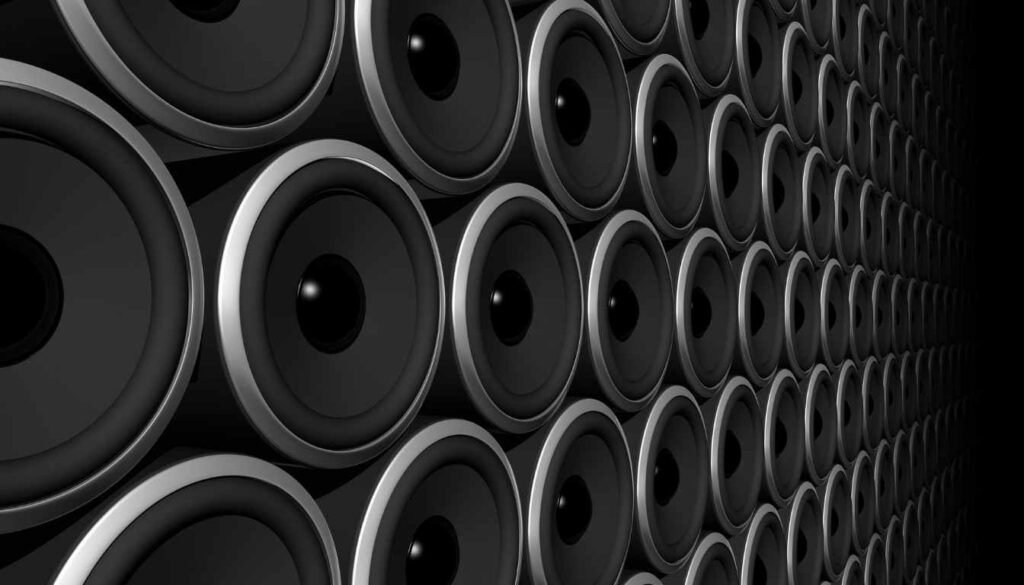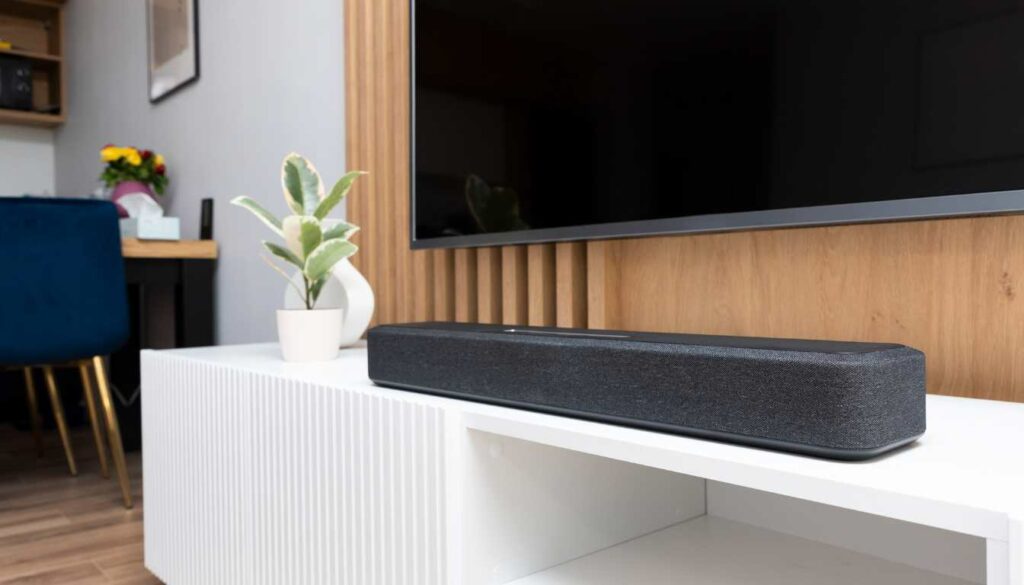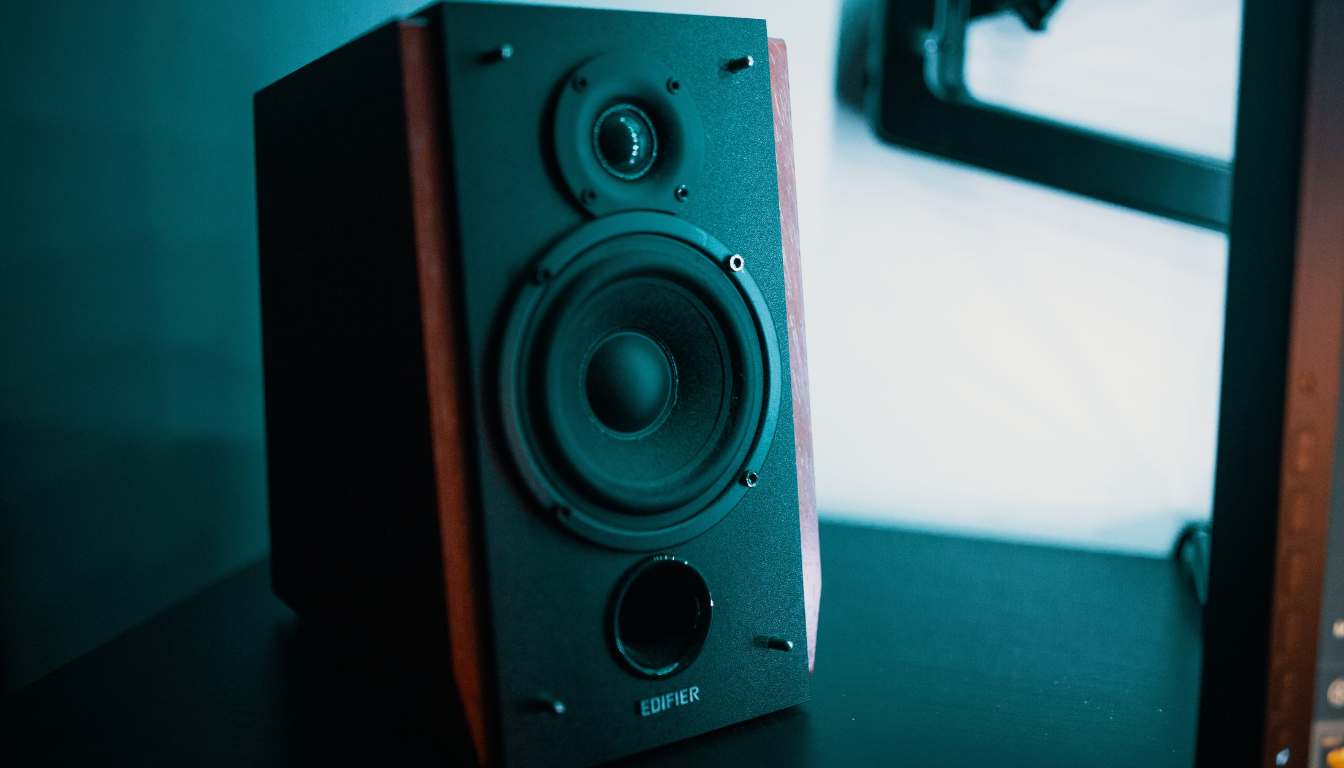So, you’re wondering what all the fuss about home surround systems is. If you are, you must be living under a rock. If so, welcome! Transforming your home sound system into a rig fit for a symphony is one of the best decisions you can make.
From sleek designs to booming bass, what’s not to love. If you’re in the market for a system that will transform your hearing experience, or are simply after some information, this article aims to be your guide.
Here we will be answering a few questions: what is a home sound system, what are the different kinds and most importantly, do you need one?
For a smaller, more discreet sound system, you might want to check out what earbuds or headphones will work for you.
A home sound system includes speakers and components for high-quality audio. Essential for immersive entertainment, it enhances movie, music, and gaming experiences, providing superior sound quality and depth to elevate home entertainment.
Table of Contents
ToggleWhat are the different types of home sound systems and speakers?
Home sound systems and speakers come in several different shapes and sizes. Many more than can be presented in a single article. However, the most common of these systems are listed below.
Surround Sound System
A surround sound system envelops listeners with multi-directional audio for an immersive experience.
It typically consists of multiple speakers strategically placed around a room, including front, rear, and center speakers, along with a subwoofer for low-frequency effects.
The system works by distributing audio signals to these speakers, creating a three-dimensional soundstage that enhances the depth and realism of audio content.
Pros
- Immersive Audio: Provides a cinematic, all-encompassing sound experience.
- Spatial Realism: Enhances audio depth and directionality.
- Versatility: Suitable for movies, music, and gaming.
Cons
- Space Requirement: Needs careful speaker placement for optimal effect.
- Cost: Quality systems can be relatively expensive.
- Installation Complexity: May require careful setup for optimal performance.
Home Theatre Sound System
A home theatre sound system is a comprehensive audio setup designed for an immersive cinematic experience.
It includes multiple speakers, a subwoofer, and often an AV receiver. Strategically placed speakers create surround sound, while the subwoofer enhances low-frequency effects.
The AV receiver processes audio signals, ensuring synchronized playback for a captivating home theatre experience.
Pros
- Cinematic Experience: Provides immersive, theatre-like audio.
- Surround Sound: Delivers spatial audio effects.
- Versatility: Suitable for movies, music, and gaming.
Cons
- Space Requirement: Needs dedicated space for optimal setup.
- Cost: High-quality systems can be expensive.
- Installation Complexity: May require professional setup.
Ceiling/Wall Speaker

Ceiling or wall speakers are discreet audio solutions integrated into the structure. Flush-mounted, they optimize space while providing immersive sound.
Typically wired to an audio source, they distribute audio evenly, delivering a seamless listening experience. Popular in-home theaters, they contribute to a clean aesthetic by eliminating the need for visible speakers.
Pros
- Space-Saving: Integrates seamlessly into the room.
- Aesthetic Appeal: Minimalist design enhances room aesthetics.
- Even Sound Distribution: Provides consistent audio coverage.
Cons
- Installation Complexity: Professional installation may be required.
- Limited Placement Options: Fixed in the ceiling or wall.
- Cost: Installation and quality systems can be relatively expensive.
TV Soundbar
A soundbar is a compact audio device designed to enhance TV audio. It houses multiple speakers in a single elongated unit, providing improved sound quality and clarity.
Typically mounted below or in front of a TV, soundbars deliver immersive audio by simulating a surround sound experience. They often connect wirelessly or via cables, offering a streamlined solution to boost the audio performance of flat-screen TVs.
Pros
- Space Efficiency: Sleek design fits well with modern TVs.
- Improved Audio: Enhances TV sound quality significantly.
- Easy Setup: Quick installation compared to multi-speaker setups.
Cons
- Limited Surround Sound: May not replicate true surround sound.
- Audio Customization: Some models may have limited EQ options.
- Dependency on TV: Audio quality may still rely on TV capabilities.

Stereo Loudspeakers
Stereo loudspeakers consist of two speakers, each responsible for distinct audio channels (left and right).
Designed for immersive sound reproduction, they deliver a spatial audio experience by utilizing the stereo audio format.
Typically, these speakers are positioned strategically to create a sense of depth and directionality in the sound, providing a lifelike listening encounter.
Pros
- Spatial Audio: Creates a realistic sense of sound direction.
- Immersive Experience: Delivers a rich, dynamic audio experience.
- Versatility: Suitable for various audio sources.
Cons
- Space Requirements: Requires careful placement for optimal effect.
- Wiring Complexity: May involve multiple cables for connection.
- Cost: Quality stereo setups can be relatively expensive.
Bluetooth/ Wireless Speaker
A wireless speaker is a compact, portable audio device that receives audio signals without physical connections.
Utilizing Bluetooth, Wi-Fi, or other wireless technologies, these speakers connect to audio sources like smartphones or computers, delivering music or other audio content.
Integrated batteries power these speakers, providing flexibility in placement. With advancements in connectivity, wireless speakers offer a hassle-free, cable-free audio experience, making them versatile for various environments, from home settings to outdoor activities.
Pros
- Portability: Easy to move and position anywhere.
- Convenience: No wires for clutter-free setups.
- Versatility: Suitable for both indoor and outdoor use.
Cons
- Battery Life: Limited by the speaker’s battery capacity.
- Audio Quality: May not match the fidelity of wired counterparts.
- Connection Range: Limited by the range of the wireless technology used.
Smart Speaker System
A smart speaker system integrates voice-controlled technology with audio playback capabilities.
These devices, often connected to virtual assistants like Amazon Alexa or Google Assistant, allow users to control music, ask questions, and manage smart home devices using voice commands.

They typically connect wirelessly to devices via Wi-Fi or Bluetooth for seamless operation.
Pros
- Voice Control Convenience: Enables hands-free operation.
- Smart Home Integration: Works seamlessly with other smart devices.
- Compact Design: Stylish and space-efficient.
Cons
- Audio Quality: May not match high-end traditional speakers.
- Privacy Concerns: Involves constant voice data processing.
Tower Speaker
A tower speaker is a vertically designed, floor-standing audio device that houses multiple speaker elements for a robust sound experience.
Typically, taller than other speaker types, it accommodates various drivers, including woofers, midrange, and tweeters, within a single, sleek enclosure.
Tower speakers are engineered to reproduce a wide frequency range, delivering rich bass, clear midrange, and crisp highs, making them ideal for home audio setups and immersive listening.
Pros
- Full-Range Sound: Tower speakers offer a broad spectrum of audio frequencies.
- Space Efficiency: Consolidates multiple drivers in a vertical design, saving floor space.
- Aesthetic Appeal: Sleek and stylish, enhancing the overall look of a room.
Cons
- Size: Larger footprint may not suit smaller spaces.
- Cost: Quality tower speakers can be relatively expensive.
- Placement Considerations: Requires careful positioning for optimal sound dispersion.
What should you consider when buying a surround sound system?
Setting up your home sound system effectively involves careful consideration of your space, equipment, and personal preferences. Here’s a step-by-step guide:
Evaluate Your Space
- Consider the size and layout of the room where the system will be installed.
- Note any acoustic challenges, such as reflective surfaces or irregular shapes.
Choose Quality Components
- Invest in quality speakers, amplifiers, and audio sources for optimal performance.
- Ensure compatibility between components for a seamless setup.
Speaker Placement
- Follow the guidelines provided with your speakers for optimal placement.
- Consider the ideal angles and distances for creating a balanced soundstage.
Calibration
- Use an audio calibration tool or the built-in calibration features in your AV receiver to optimize speaker settings.
- Adjust speaker levels, distances, and crossover frequencies to achieve balanced sound.
Wiring and Connectivity
- Use high-quality cables and connectors for reliable connections.
- Organize cables to minimize clutter and prevent interference.
Room Acoustics
Consider acoustic treatments, such as rugs, curtains, or wall panels, to manage sound reflections and absorb unwanted echoes.
AV Receiver Settings
- Configure your AV receiver’s audio settings according to the capabilities of your speakers.
- Set up audio processing features like Dolby Atmos or DTS:X if your system supports them.
Source Selection
- Connect your audio sources (TV, streaming devices, Blu-ray players) to the AV receiver.
- Ensure your source devices are set to output audio in the highest quality possible.

Testing and Fine-Tuning
- Play various types of audio content to test the system’s performance.
- Make adjustments to speaker levels, equalization, and other settings based on your preferences.
Remote Control and Automation
- Program your remote control or utilize automation features for convenience.
- Explore smart home integration options if available.
Regular Maintenance
- Periodically check and update firmware for your components.
- Dust speakers and clean connectors to maintain optimal performance.
Remember that individual preferences play a significant role in audio setup, so take the time to fine-tune settings based on your listening preferences.
Additionally, seeking professional advice or assistance for complex setups can ensure the best results.
How important is the power and wattage of an amplifier in a home sound system?
The power and wattage of an amplifier significantly impact a home sound system, influencing audio quality and overall performance. Key considerations include:
Speaker Drive: Amplifiers provide the necessary power to drive speakers, preventing distortion and ensuring faithful sound reproduction.
Volume and Dynamics: Higher wattage amplifiers offer more headroom, enabling cleaner and more dynamic sound, particularly during intense audio passages.
Speaker Control: Adequate power enhances control over speakers, preventing issues like clipping or overloading.
Room Size: The size of the room influences the required amplifier power, with larger spaces often needing more potent amplifiers for effective sound coverage.
Speaker Sensitivity: Matching amplifier power to speaker sensitivity is crucial; less sensitive speakers may require more power.
Efficiency: Advances in amplifier technology allow for efficient designs, enabling lower-wattage amplifiers to deliver impressive performance.
Balancing these factors ensures optimal sound quality in a home sound system, emphasizing the importance of selecting the right amplifier power for specific speakers, room dimensions, and musical preferences.

How do I improve acoustics in different rooms of the house?
Improving acoustics in your house can significantly enhance the performance of your sound system. Here are practical steps to achieve better acoustics:
Add Soft Furnishings: Introduce rugs, curtains, and upholstered furniture to absorb sound reflections and minimize echoes.
Install Acoustic Panels: Place acoustic panels strategically on walls to control sound reflections and enhance overall sound quality.
Strategic Speaker Placement: Experiment with optimal speaker placement to achieve balanced sound distribution.
Use Bass Traps: Install bass traps in corners to control and absorb low-frequency sounds.
Ceiling Clouds: Employ suspended baffles or clouds on the ceiling to absorb sound and reduce reverberation.
Carpeting or Area Rugs: Utilize carpets or rugs on floors to dampen sound and minimize transmission through hard surfaces.

Do I need a home sound system or home speaker?
Deciding on whether you need a home sound system or speaker, as well as which type to go for depends on your audio needs.
A home sound system, comprising amplifiers and multiple speakers, is ideal for immersive experiences in larger spaces, catering to movie enthusiasts or music aficionados.
Standalone speakers, such as bookshelf or tower speakers, suit simpler setups and smaller rooms, providing quality audio for casual listeners. Portable Bluetooth speakers are great for on-the-go music lovers.
Consider your space, usage, and desired audio quality—whether for cinematic experiences, music appreciation, or convenience—when deciding on a home sound system or standalone speakers.
With any luck, your sound system will be loud enough to cancel out the noise of your vaccuum. Or you could just choose the right vacuum. Check out the linked article to find out more.

